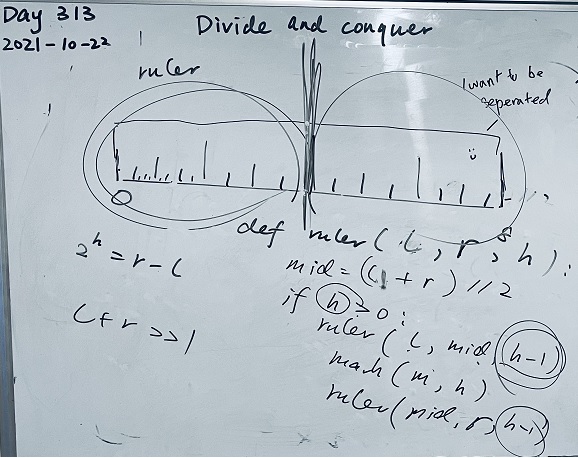Teaching Kids Programming: Videos on Data Structures and Algorithms
We have used the Divide and Conquer algorithm to solve some problems earlier. For example, for Hanoi Tower, we solve the problem by dividing into three steps: moving n-1 disks from A to B, moving disk-n to C, and moving n-1 disks from B to C. The first and third steps are carried on recursively.
Also, the merge sort algorithm is a good example of divide and conquer. We divide the elements in two halves, recursively merge-sort them and then we can merge two sorted list into a sorted array.
Advantages of Divide and Conquer – why we use it?
For big problems, it might be easier to solve a smaller problems by divide-and-conquer. Also, the sub problems are independent and they can be solved separately at the same time – which means we can use multithreading/parallelism to speed the performance.
Divide and Conquer to Get the Maxmium
Consider the following linear version – go through elements one by one and keep the maximum:
1 2 3 4 5 6 | def max(nums): ans = -math.inf for i in nums: if i > ans: ans = i return ans |
def max(nums):
ans = -math.inf
for i in nums:
if i > ans:
ans = i
return ansTime complexity obviously O(N) and space complexity O(1).
We can divide the numbers into two halves and obtain the sub-max for both halves, then return the max of them. As we divide and recursively solve the sub problems, we need to tell computers how to handle the base case which is only one element – then it is the max.
1 2 3 4 5 6 7 | def max(nums): if len(nums) == 0: return nums[0] mid = len(nums) // 2 leftMax = max(nums[:mid]) rightMax = max(nums[mid:]) return leftMax if leftMax > rightMax else rightMax |
def max(nums):
if len(nums) == 0:
return nums[0]
mid = len(nums) // 2
leftMax = max(nums[:mid])
rightMax = max(nums[mid:])
return leftMax if leftMax > rightMax else rightMaxDivide and Conquer Strategy to Mark a Ruler
We can mark a ruler with 3 steps (divide and conquer) – first mark the center with height h, then second step is to mark the left with height-1 and finally mark the right with height-1.
1 2 3 4 5 6 7 8 9 10 11 12 13 14 15 | def ruler(l, r, h): mid = l + r >> 1 if h > 0: ruler(l, mid, h - 1) print("Mark %d with height = %d" % (mid, h)) ruler(mid, r, h - 1) ruler(0, 8, 3) # Mark 1 with height = 1 # Mark 2 with height = 2 # Mark 3 with height = 1 # Mark 4 with height = 3 # Mark 5 with height = 1 # Mark 6 with height = 2 # Mark 7 with height = 1 |
def ruler(l, r, h):
mid = l + r >> 1
if h > 0:
ruler(l, mid, h - 1)
print("Mark %d with height = %d" % (mid, h))
ruler(mid, r, h - 1)
ruler(0, 8, 3)
# Mark 1 with height = 1
# Mark 2 with height = 2
# Mark 3 with height = 1
# Mark 4 with height = 3
# Mark 5 with height = 1
# Mark 6 with height = 2
# Mark 7 with height = 1–EOF (The Ultimate Computing & Technology Blog) —
loading...
Last Post: Teaching Kids Programming - Area and Circumferences of Circle and Monte Carlo Simulation Algorithm of PI
Next Post: Different ways of Loading Javascript Files in a Javascript File
